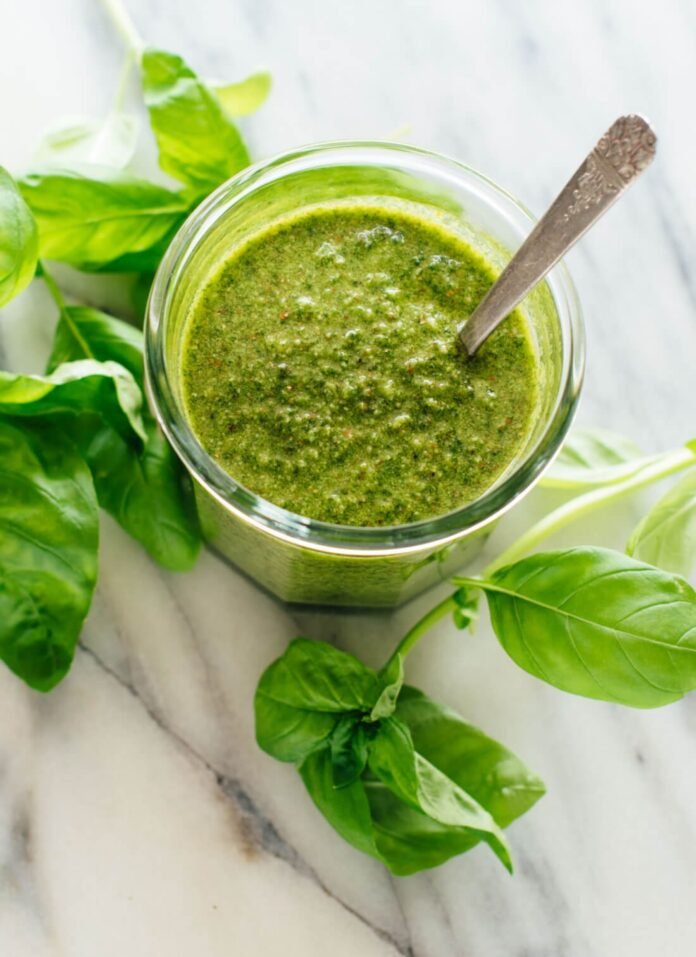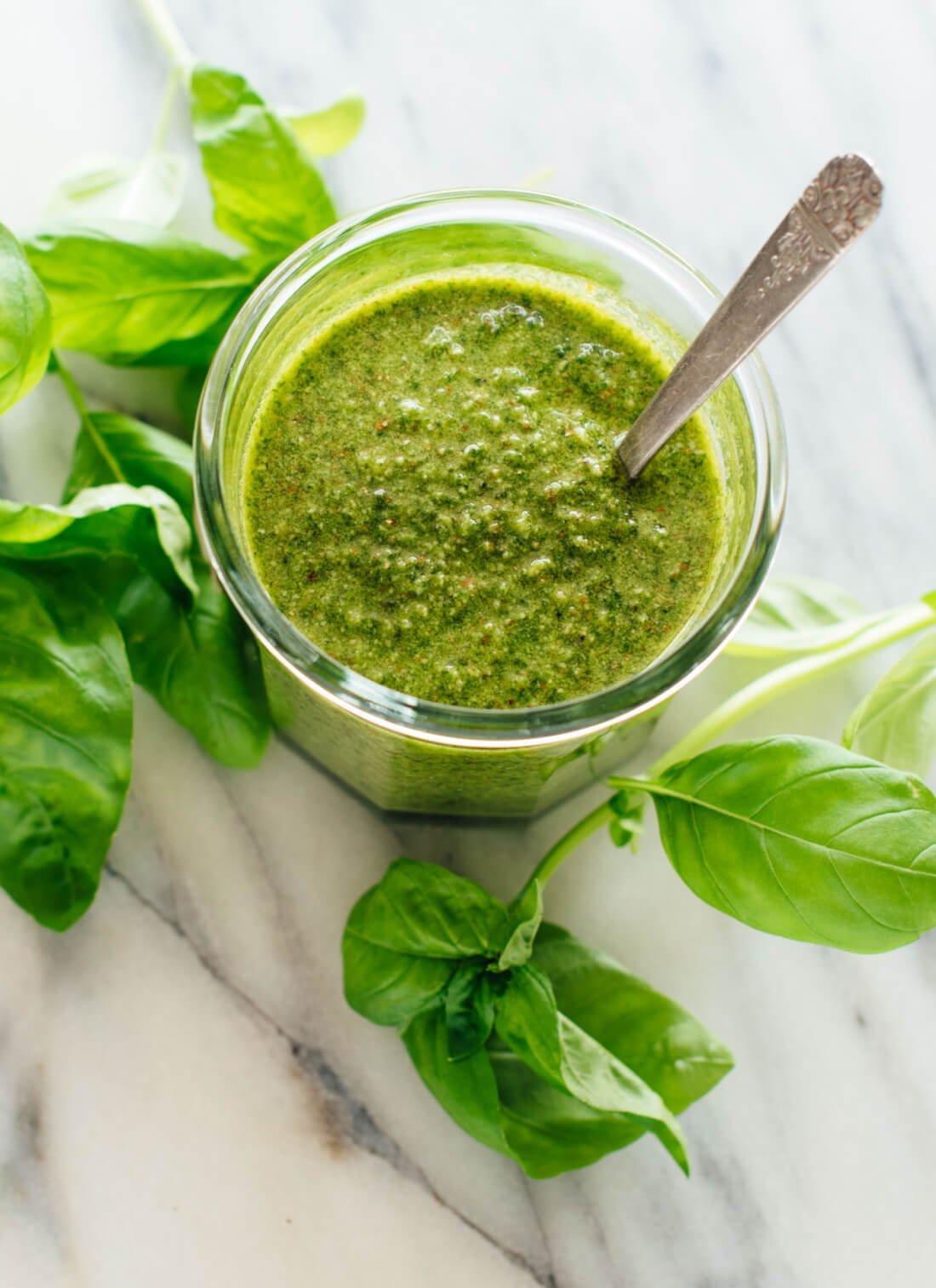
Let’s talk about basil pesto! Have you made homemade pesto before? It’s one of my favorite, ultra-flavorful sauces. I love to make it in the warmer months when fresh basil is in season.
Great pesto tastes fresh, herbal, nutty, garlicky and luxurious, all at once. Today, I’m sharing my favorite pesto recipe and my best pesto tips. I’ve followed this formula for years, and it never lets me down.
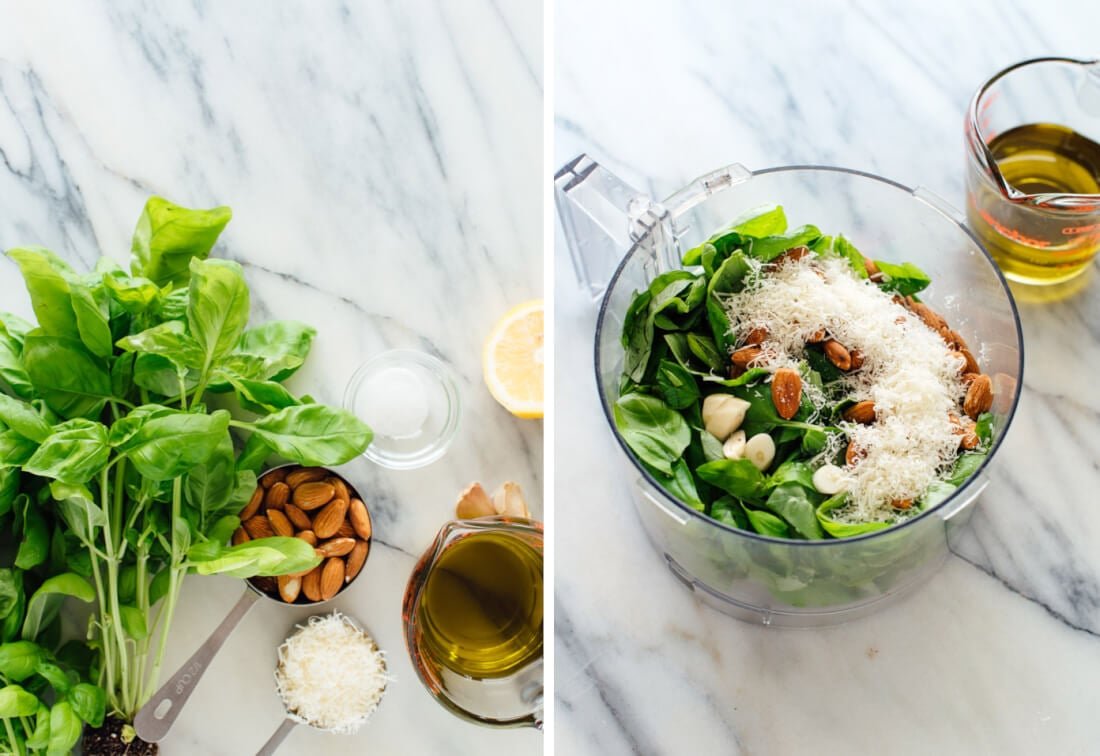
Homemade pesto is infinitely more tasty than store-bought varieties. Jarred pesto can be expensive, too. It’s cheaper to make your own, and then you can use it liberally! While pesto always seems fancy and gourmet, homemade pesto is very easy to make in your food processor or blender.
Pesto originated in Liguria, Italy, where pesto is made in a mortar and pestle. (In fact, “pestâ” means “to pound.”) I don’t have the patience to crush basil by hand, one handful at a time, so I recommend using a food processor instead.
Watch How to Make Pesto
Uses for Classic Basil Pesto
Pesto is traditionally served on pasta, but don’t stop there. Add it to anything that could benefit from a jolt of fresh basil sauce. You can serve it cold or warm; know that if you heat it up significantly, it will turn a darker color.
If you’d like to incorporate vegetables, pesto pairs well with tomatoes, artichoke, eggplant, bell peppers, mushrooms, peas, new potatoes and cauliflower. Make a meal by adding pesto to any of the following foods.
- Pasta: Generally speaking, the best pasta shapes for pesto are thin spaghetti or angel hair, twisted shapes like fusilli, and bow-ties.
- Zucchini noodles: Use all zoodles or a combination of zoodles with spaghetti.
- Pizza: Keep it simple with pesto and mozzarella, or add veggies like tomatoes, olives, or thinly sliced summer squash.
- Sandwiches: Spread it directly onto bread or stir in mayonnaise to make a more mellow, creamy sauce.
- Salads: Turn pesto into a lively dressing by thinning it with more olive oil and lemon juice, to taste.
- Find more pesto ideas here.
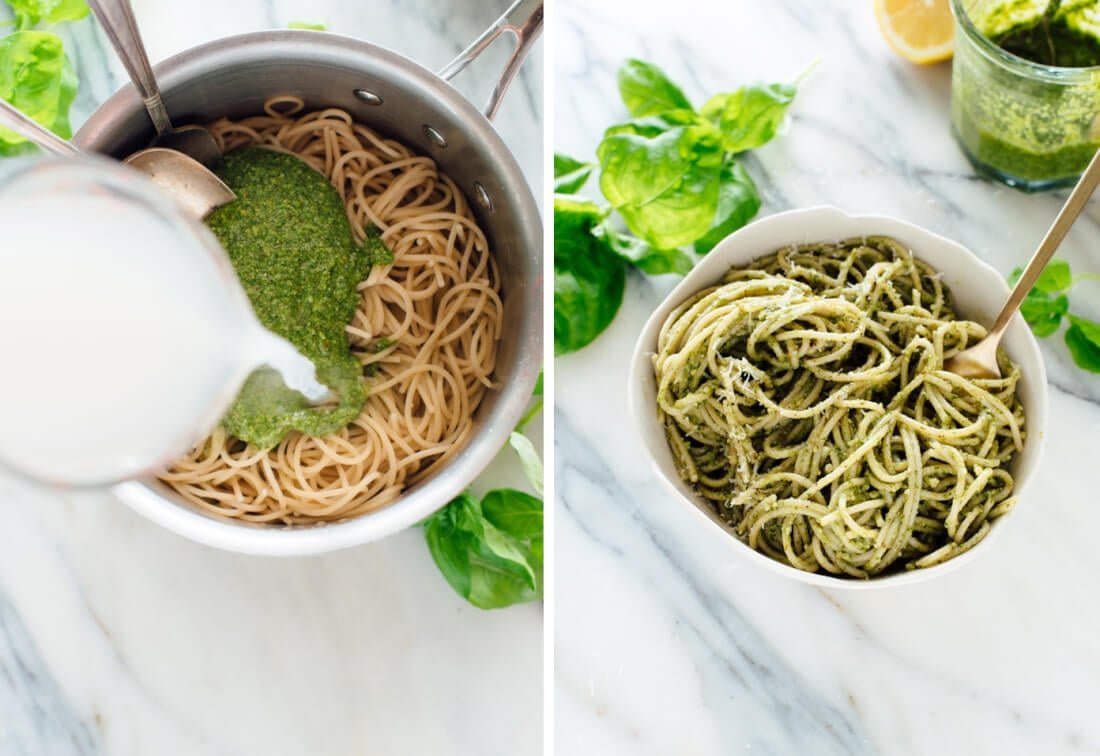
Basil Pesto Ingredients
Traditional pesto alla genovese is made simply with basil, pine nuts, Parmesan, garlic, salt and olive oil. These healthy ingredients yield a rich and delicious sauce. I often change up the herbs or nuts and add a squeeze of lemon juice. Read on to learn why!
Fresh Basil
Pesto is the perfect use for your summer garden basil surplus, and you can freeze the extra for later. Don’t have a garden? My favorite sources for affordable fresh basil are the farmers’ market, Trader Joe’s, or those little basil plants (“living basil” or potted) from grocery stores.
Wash and dry your basil well before using it—wet basil waters down the flavor of the pesto and can turn it an unappetizing dark color. You can either shake the leaves dry and let them air dry on a towel or pat them dry.
Kenji from Serious Eats says you can use frozen basil leaves. If you ever have extra basil leaves—rinse, dry thoroughly, and put them in a freezer bag for future pesto!
Variations: Substitute arugula when basil is out of season. Kale, cilantro and parsley also make lovely pestos. You honestly can’t go wrong.
Pine Nuts or Other Nuts/Seeds
Pine nuts are the traditional choice (did you know they’re actually pine cone seeds?). Pine nuts are tender, buttery and high in fat, so they yield smoother, silkier pesto. On the downside, pine nuts are prohibitively expensive.
Variations: I often save money by using raw almonds, walnuts, pecans, pistachios, pepitas (green pumpkin seeds) or hemp hearts instead. Almonds are the most neutral option, so I used them for the pesto you see here. They’re all tasty in their own way.
I typically toast the nuts first to enhance their flavor and add an extra-savory edge to the pesto.
Parmesan
Parmesan is salty and creamy, and tones down basil’s anise flavor. You can use Pecorino Romano for a more prominent cheesy flavor. Parmesan is not typically vegetarian (it usually contains animal rennet), but Whole Foods and BelGioioso offer vegetarian varieties.
If you’re vegan or dairy free, you can use a smaller amount of nutritional yeast instead (see recipe note). Sometimes, if I’m in the mood for extra-bold pesto, I just leave it out altogether or sprinkle vegan Parmesan cheese on my finished dish, to taste.
Garlic
Garlic is a traditional component that adds aromatics and makes the pesto taste more interesting. Don’t skip it.
Lemon Juice
I always add a squeeze of lemon juice to my pesto to brighten up the flavor without adding more salt. It’s optional, but I think you’ll like it!
Salt
Salt amps up all the other flavors and reduces the bitterness of the basil. If your pesto doesn’t taste amazing on the first bite, try adding another pinch or two of salt.
Extra-Virgin Olive Oil
Extra-virgin olive oil is the highest quality and comes from the first pressing of the olives. My favorite brands are California Olive Ranch and Trader Joe’s Kalamata olive oil.
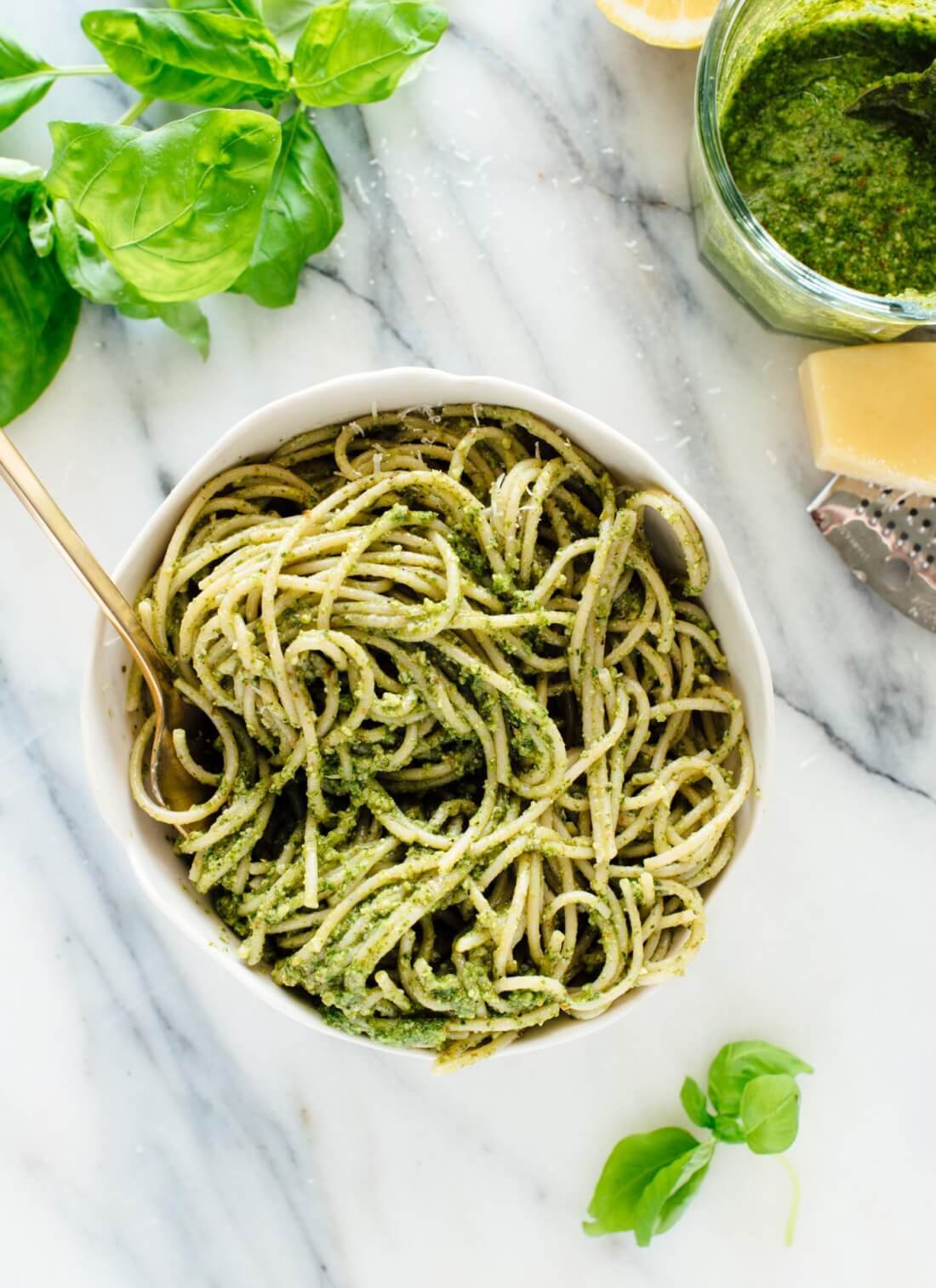
Basil Pesto
Homemade basil pesto is so easy to make! Learn how to make basil pesto with this recipe, plus learn how to properly toss it with pasta, and freeze leftovers. Recipe yields 1 cup pesto, which is enough to toss with about 12 ounces of pasta.
- (Optional) Toast the nuts or seeds for extra flavor: In a medium skillet, toast the nuts/seeds over medium heat, stirring frequently (don’t let them burn!), until nice and fragrant, 3 to 5 minutes. Pour them into a bowl to cool for a few minutes.
- To make the pesto, combine the basil, cooled nuts/seeds, Parmesan, lemon juice, garlic and salt in a food processor or blender. With the machine running, slowly drizzle in the olive oil. Continue processing until the mixture is well blended but still has some texture, pausing to scrape down the sides as necessary.
- Taste, and adjust if necessary. Add a pinch of salt if the basil tastes too bitter or the pesto needs more zing. Add more Parmesan if you’d like a creamier/cheesier pesto. If desired, you can thin out the pesto with more olive oil. (Consider, however, that if you’re serving the pesto on pasta, you can thin it with small splashes of reserved pasta cooking water to bring it all together. See notes for details.)
- Use pesto as desired; there’s no need to cook it. Store leftover pesto in the refrigerator, covered, for up to 1 week. You can also freeze pesto—my favorite way is in an ice cube try. Once frozen, transfer to a freezer bag, then you can thaw only as much as you need later.
Notes
Make it dairy free/vegan: Replace the Parmesan with 1 tablespoon nutritional yeast.
Make it nut free: Use pine nuts, pepitas or sunflower seeds. (Pine nuts are technically seeds, but if you’re allergic to nuts, there’s a chance you’ll be allergic to pine nuts, too.)
Parmesan note: Most Parmesans are not technically vegetarian (they contain animal rennet), but Whole Foods 365 and BelGioioso brands offer vegetarian Parmesan cheese.
How to toss pesto with pasta: Before you drain your pasta, place a liquid measuring cup in the sink. Then, pour about 1 cup of the pasta cooking water into the measuring cup before you drain off the rest of the water. That pasta cooking water is pure gold—it contains starches that create a creamy emulsion and help attach the sauce to the pasta. Off the heat, toss pasta, pesto and small splashes of pasta cooking water together until you’re satisfied with the consistency (I used roughly ⅓ cup reserved pasta cooking water for ½ pound of spaghetti).
Nutrition
The information shown is an estimate provided by an online nutrition calculator. It should not be considered a substitute for a professional nutritionist’s advice. See our full nutrition disclosure here.

